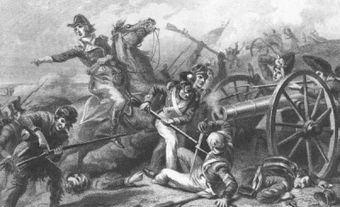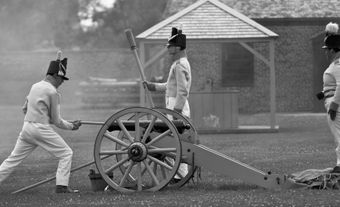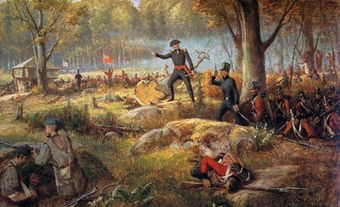Nancy Island Historic Site
Nancy Island Historic Site is situated about 2 km from the mouth of where the Nottawasaga River flows into southern GEORGIAN BAY, Ont. The HISTORIC SITE carries the name of the schooner NANCY, built in Detroit for partners in the NORTH WEST COMPANY in 1789, and brought into imperial service during the WAR OF 1812. At this location, the schooner met a fiery end.
The Nancy, under the command of Master Alexander Mackintosh, was a supply vessel taken into the British government service. The vessel came under the general command of Henry PROCTER and aided the British war effort in taking Detroit and during the unsuccessful attacks on Fort Meigs (Perrysburg, Ohio). In early October 1813 while returning to Fort Amherstburg from a supply mission to FORT MICHILIMACKINAC on Lake Huron, the Nancy found the Americans in control of Lakes St Clair and Erie (seeBATTLE OF LAKE ERIE). The schooner narrowly escaped capture after entering the ST CLAIR RIVER and spent the winter at SAULT STE MARIE.
Scuttling of the Nancy
During 1814, the Nancy ran supplies from the mouth of the Nottawasaga River to Fort Michilimackinac. When the Americans began searching for British ships in Lake Huron, her new commander, Lieutenant Miller Worsley, under orders, hid the schooner upriver of the Nottawasaga River's mouth and erected a blockhouse as a means of defence. Three American ships discovered the hideout and on 14 August 1814, began shelling its position. The bombardment was fierce, which led Worsley to order the Nancy demolished rather than have it fall into enemy hands. This was done by a powder train laid between the blockhouse and the vessel, and then setting the Nancy on fire (although the Americans reported that it was one of their shells that started the fire). In the resulting confusion, Worsley and his men escaped. What remained of the vessel settled to the river's bottom. Around the sunken hull, an island subsequently developed.
The story of the Nancy has become the subject of song, story and legend and will always be seen as doughty resistance in the face of overwhelming enemy might. Part of the story belongs to the schooner's commander, Lieutenant Worsley. After he and his men escaped, he succeeded in seizing the American schooners Scorpion and Tigress, 2 of the ships that sunk the Nancy, and re-established some sense of British naval presence on Lake Huron and Georgian Bay in late 1814. Peace came on 24 December 1814.
The Nancy Resurfaces
Historian of the War of 1812, Colonel Ernest Cruikshank, saved the all-but-forgotten story of the Nancy and published his findings in 1910. In 1911, Toronto journalist and historian Charles H.J. Snider found what he thought was the charred hull in the middle of the Nottawasaga River. At least one 24-pounder round shot was found nearby by dentist Dr. Frederick J. Conboy who after many months of searching finally, in 1927, found the schooner. Unearthed and raised, the hull was placed a short distance from where it had been found. In 1928, the first Nancy museum was opened. In 1934, a model was completed, with Snider playing a leading role in its construction.
The actual hull of the vessel can now be seen in a climate-controlled chamber in the WASAGA BEACH complex. Built in 1968, the complex consists of a museum, theatre and lighthouse. The architectural features of the museum were inspired by sails straining against wind. The museum holds military artifacts of the event and various displays. In 1978, management of the site became the responsibility of Wasaga Beach Provincial Park.
In 1923, the Historic Sites and Monuments Board of Canada designated the Nancy under the category of a national historic event and put up a cairn to commemorate it in 1954. Today the locale is known as Nancy Island Historic Site.
See alsoWAR ON THE LAKES IN THE WAR OF 1812.

 Share on Facebook
Share on Facebook Share on X
Share on X Share by Email
Share by Email Share on Google Classroom
Share on Google Classroom


